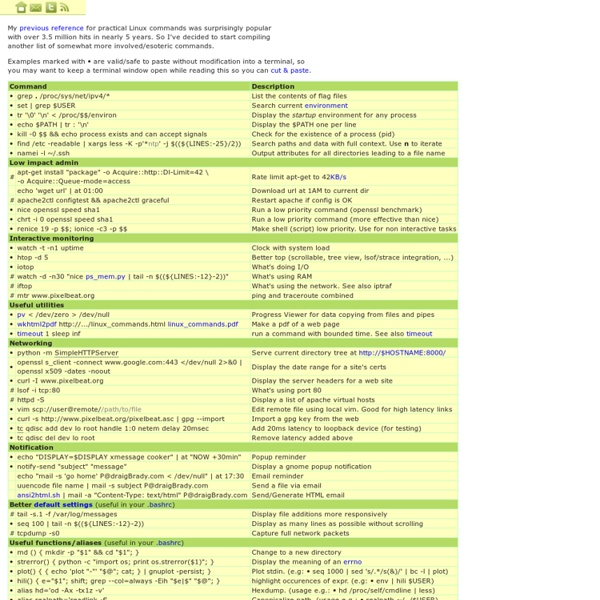



Command line tricks for smart geeks Everyone knows the answer to the question of life, the universe and everything is "42", but for the first time we can reveal the question. It is this: how many command-line tricks must a man memorise? You see, graphical user interfaces are all well and good, but when you want to get real work done it's time to switch to the terminal. And so, we squeezed our brain cells, dug through dusty piles of old issues of Linux Format, and sat reflecting quietly over many a pint of ale, all with the goal of bringing you this: 42 awesome new command line tricks we think you ought to commit to memory. We've tried to include a few that are easier for our, er, less-experienced readers to enjoy, but we think even the most hardened Linux veteran will learn something new over the next 12,000 words. So, strap yourself in and get ready for command-line heaven: it's time to kick ass and chew bubble gum, and we're all out of gum... Make your own Bash wormholes cat /var/log/messages | less Remote control MPlayer . .
Learn Linux, 101: The Linux command line Overview This article gives you a brief introduction to some of the major features of the bash shell, and covers the following topics: Interacting with shells and commands using the command lineUsing valid commands and command sequencesDefining, modifying, referencing, and exporting environment variablesAccessing command history and editing facilitiesInvoking commands in the path and outside the pathUsing man (manual) pages to find out about commands This article helps you prepare for Objective 103.1 in Topic 103 of the Junior Level Administration (LPIC-1) exam 101. The objective has a weight of 4. The material in this article corresponds to the April 2009 objectives for exam 101. Back to top The bash shell The bash shell is one of several shells available for Linux. Before we delve deeper into bash, recall that a shell is a program that accepts and executes commands. Shells have some builtin commands, such as cd, break, and exec. Shells also use three standard I/O streams: Listing 1. Echo
All commands Linux Newbie Guide by Stan, Peter and Marie Klimas Intro. We are relative Linux newbies (with Linux since Summer 1998). We run mostly RedHat and Mandrake -> the solutions might not be directly applicable to other Linux distributions (although most of them probably will be). Hope this helps; we try to be as practical as possible. Of course, we provide no warranty whatsoever. General description of this Guide. Conventions: <> = single special or function key on the keyboard. Part 0: For the Undecided (Linux Benefits) If you are wondering what the Linux pros and cons are, and whether Linux is for you. Part 1: Before Linux Installation What distribution should I use, how to obtain it, Linux hardware requirements, how to partition your hard drive, about dual boot, which packages to install, which graphical user interface (GUI) to install (gnome or kde?) Part 4.4: Basic Configurations Real basics on how to configure the printer and soundcard, bits about configuration files, daemons, and device files.
Malicious Linux Commands - From (This article was originally published in Ubuntu Forums but was removed there. Ubuntuguide feels that knowledge about these risks is more important than any misguided attempts to "protect the public" by hiding their potential dangers or protect the (K)Ubuntu/Linux image. ATTENTION: It is worthwhile to have some basic awareness about malicious commands in Linux. It is also worthwhile to always enable a Kubuntu screensaver or Ubuntu screensaver with a password so that a casual passerby is not able to maliciously execute one of these commands from your keyboard while you are away from your computer. When in doubt as to the safety of a recommended procedure or command, it is best to verify the command's function from several sources, such as from readily available documentation on Linux commands (e.g. manpages). Here are some common examples of dangerous commands that should raise a red flag. Delete all files, delete current directory, or delete visible files in current directory rm -r or